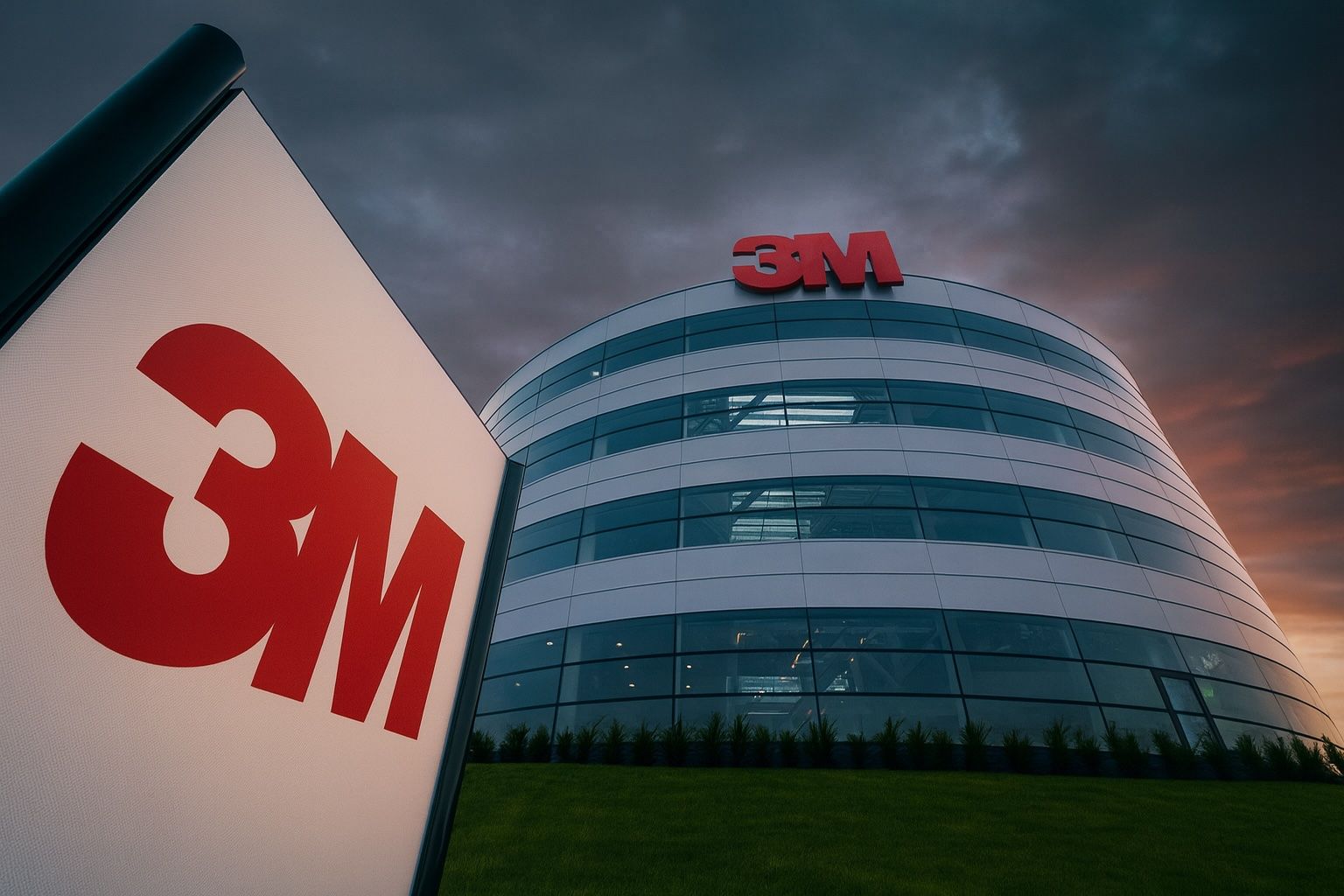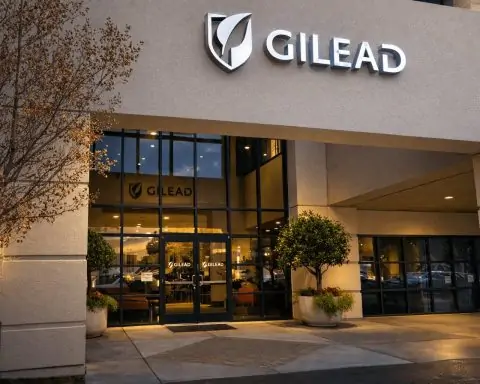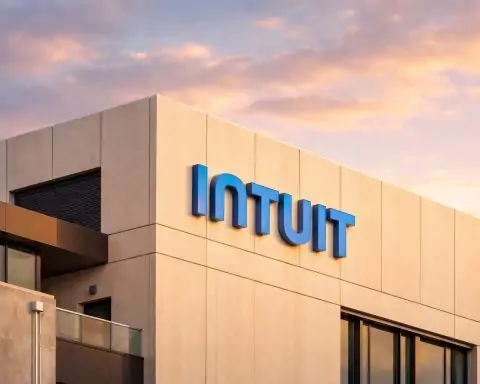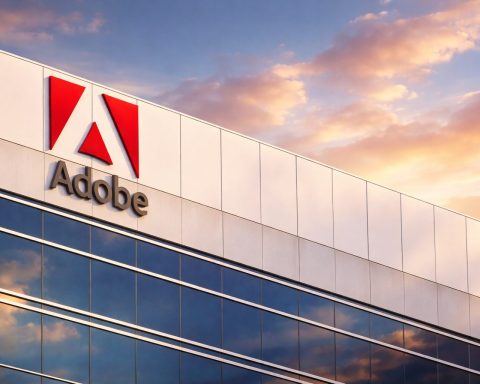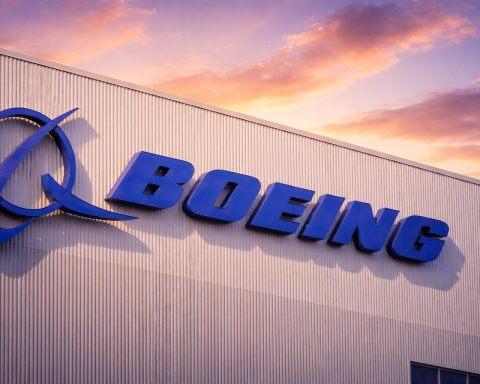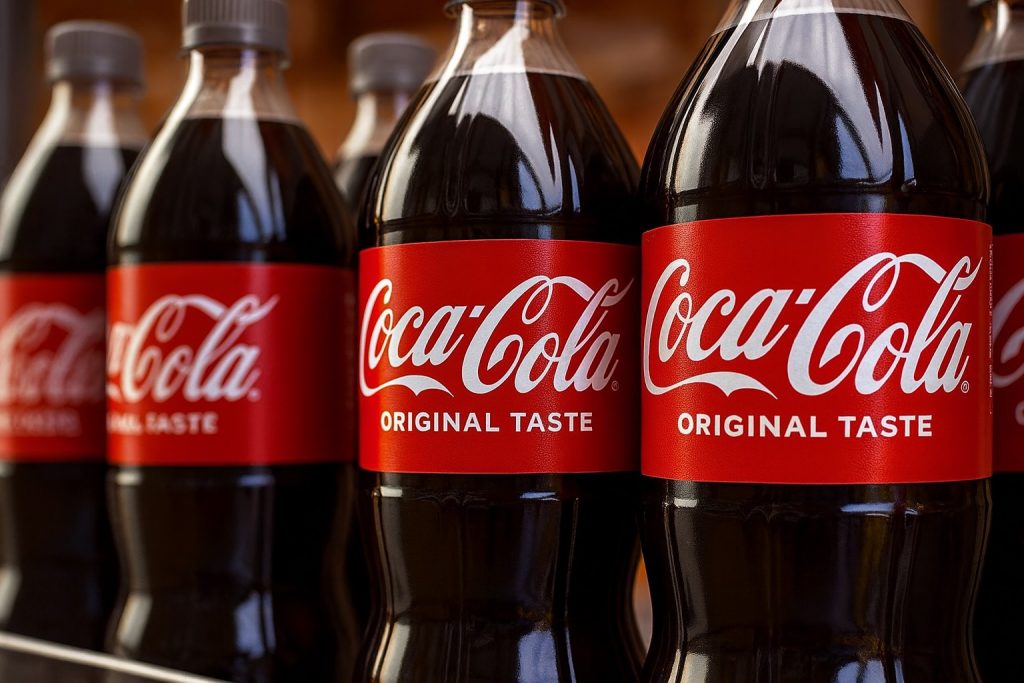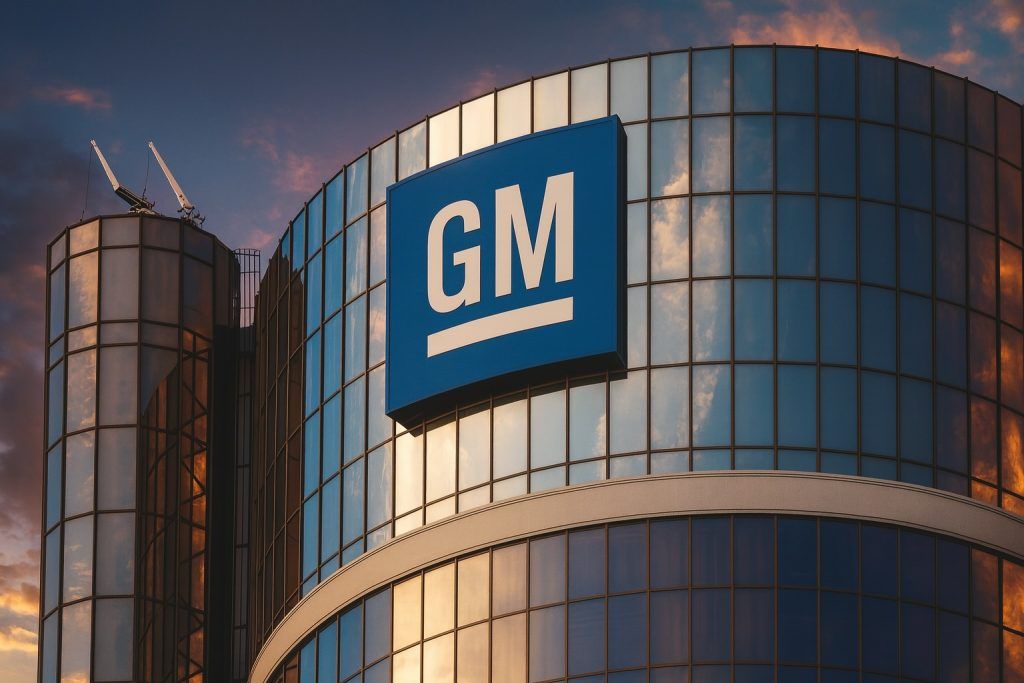- Stock Price Rally: 3M Company (NYSE: MMM) closed at $154.78 on Oct. 20, 2025, up about +3.7% over the past quarter and roughly +17.5% year-on-year [1]. Shares have outpaced the broader market in recent months, and early premarket trading on Oct. 21 showed a further uptick after strong earnings news. The stock’s 52-week range is approximately $122 – $164, and year-to-date gains are in the high single digits.
- Q3 Earnings Beat & Guidance Hike:3M’s Q3 2025 results topped expectations. The company reported adjusted earnings per share (EPS) of $2.19 (beating consensus $2.07) on $6.3 billion revenue (vs. $6.25B expected) [2]. Organic sales grew ~3% and operating margins improved, reflecting CEO Bill Brown’s aggressive cost-cutting. Full-year 2025 EPS guidance was raised to $7.95–$8.05 (from $7.75–$8.00 prior) [3], marking the second straight quarterly upgrade [4]. 3M now projects >2.5% sales growth for 2025 and noted stronger cash flow outlook, signaling fresh momentum going into year-end.
- Dividends & Shareholder Returns: 3M pays a quarterly dividend of $0.73 per share (annual $2.92), which has been maintained at this level (no recent increase). At current share prices, the dividend yield is ~1.9% [5]. The industrial giant boasts 100+ years of uninterrupted dividends and is a renowned dividend stalwart. Management has pledged to return ~$10 billion to shareholders over 2025–2027 via dividends and buybacks [6], after returning about $3.8B in 2024 and $1.3B in the first half of 2025.
- Legal Liabilities Overhang:Legacy lawsuits remain a drag. 3M faces multibillion-dollar liabilities from PFAS “forever chemicals” and military earplug litigation. It agreed to a $12.5 billion settlement in 2023 for PFAS contamination of water systems [7] and a $6 billion settlement to resolve ~300,000 earplug claims [8]. However, thousands of PFAS cases are still pending; analysts estimate $5–15 billion in additional PFAS payouts could be required [9]. A federal bellwether trial over PFAS in firefighting foam is set for late October 2025 [10] [11], which could shape further settlements. 3M is ceasing PFAS production by end-2025 to mitigate future risk [12] and has had to absorb large litigation costs (~$2.2 B cash outflow in Q2 2025 related to legal payments) [13].
- Analyst Sentiment – Cautious Optimism: Wall Street has grown moderately bullish on MMM. The stock carries a “Moderate Buy” consensus rating, with roughly 9 Buy, 2 Hold, 1 Sell recommendations [14]. The average 12-month price target is about $169 per share, ~10% above the latest price [15]. Several analysts have raised price targets in recent weeks: e.g. J.P. Morgan to $178 (Overweight) [16], Wells Fargo to $176 [17], and Deutsche Bank to $185 [18], citing 3M’s improving margins and cash flow. While the outlook is brighter, some caution that at ~20× earnings the stock’s valuation already reflects much of the near-term good news [19].
- Industry Comparisons: 3M trades at about 20× earnings, a valuation slightly below peers like Honeywell (HON, ~23×) and well under General Electric (GE, ~40×) [20]. Its dividend yield (~1.9%) is on par with Honeywell (~2%) and vastly higher than GE’s negligible payout [21] [22]. 3M’s year-to-date stock performance (+≈10%) is solid, though HON has benefited more from a booming aerospace cycle, and GE’s post-split shares are influenced by its focused aerospace business. Overall, 3M offers a defensive profile – it’s often seen as a steadier, income-oriented industrial – trading at a reasonable price relative to peers with similar yield [23].
Stock Performance & Recent Moves
3M’s stock has been grinding higher in 2025 after a rough prior decade. Shares are hovering in the mid-$150s – near their highest levels of the past year, though still below pre-2020 peaks. As of the Oct. 20 close, MMM was at $154.78, having climbed about +17.5% in the past 12 months [24]. By comparison, the S&P 500 is up roughly mid-teens percentage over a similar period (so 3M has slightly outperformed the broader market). Year-to-date, 3M’s gains are in the high single digits to low teens range, depending on the baseline – a notable improvement considering the stock languished near multi-year lows around $120–$130 not long ago.
In October specifically, 3M’s stock saw a bit of turbulence. It traded in the $145–$155 range through early October [25], then dipped about 6% in one week amid a general market pullback [26]. However, momentum shifted leading into mid-month: the Dow Jones Industrial Average (of which 3M is a component) rallied strongly on hopes of easing interest rates and positive earnings from tech giants. 3M’s shares rebounded back to the high-$140s and then into the $150s ahead of its own earnings. On Monday Oct. 20, the stock jumped alongside a broad market surge (the Dow leapt 500+ points that day). Premarket on Oct. 21, following 3M’s earnings release, MMM shares were indicated up about +1% [27] as investors digested the upbeat results and guidance (detailed below).
Volatility in 3M has been moderate. The stock’s beta is around 1.05 [28], meaning it tends to move roughly in line with the overall market. Its 52-week low was roughly in the low $120s during late 2024’s selloff, and the 52-week high around $164 was touched earlier this year amid optimism on an initial legal settlement. At current levels, 3M is about +30% above its lows of last year, but still well below its all-time high (which was over $250 back in 2018 before litigation fears set in).
Valuation-wise, 3M’s trailing price-to-earnings (P/E) ratio is in the ~20× range [29]. That is a bit lower than other diversified industrial peers – for instance, Honeywell trades around ~23× earnings, and Illinois Tool Works (another multi-industry manufacturer) is in the mid-20s. General Electric appears expensive at ~40×, but that is partly due to its ongoing transformation (post-spinoff earnings are still normalizing) [30]. 3M’s slightly discounted P/E suggests the market has been cautious due to the company’s legal overhangs and slower growth. However, with earnings now improving (and legal uncertainties gradually clearing), there may be room for multiple expansion if 3M can regain investor confidence.
In terms of dividend yield, 3M’s ~1.9% yield [31] is on the lower side historically (it exceeded 3% during the stock’s slump). The yield looks modest compared to many other Dow components or industrials – for example, Caterpillar yields ~2.1%, Honeywell ~2.0%, but GE’s yield is effectively 0% after cutting its dividend in recent years [32]. The relatively low yield today is a function of 3M’s stock price recovery (the payout itself hasn’t been cut). For investors, this signals that 3M is no longer the deep-value bargain it was at its trough, but rather is pricing in some improved outlook.
Latest Earnings Fuel Renewed Optimism
3M’s Q3 2025 earnings, reported on the morning of Oct. 21, delivered a dose of good news. The company’s results beat analyst expectations on both the top and bottom line, and management took the opportunity to raise guidance for the full year.
- EPS Beat: Adjusted earnings came in at $2.19 per share, about $0.12 higher than Wall Street’s $2.07 consensus [33]. This marks a solid earnings beat of ~+6%. However, it’s worth noting that on a GAAP basis (including special charges), EPS was lower – around $1.55 – due to litigation and restructuring expenses. The adjusted figure strips out those one-time costs to better reflect the operating performance.
- Revenue Beat: Sales for Q3 were $6.3 billion, slightly above the ~$6.25 B expected [34]. In fact, overall reported revenue was about $6.5 B [35] when including certain one-time gains, but on an apples-to-apples adjusted basis it was $6.3B. Importantly, organic local-currency sales (which exclude divested businesses and currency swings) rose about +3.2% year-on-year [36]. This indicates that 3M’s core business is back to growth – a notable turnaround from basically flat sales last year.
- Margin Expansion: Behind the earnings beat was a clear improvement in profitability. 3M’s adjusted operating margin increased by +170 basis points (1.7 percentage points) in Q3 [37]. Management has been laser-focused on cost reductions and efficiency, and it’s paying off. Gross margins and operating margins are climbing as the company rightsizes. In CEO Bill Brown’s words, 3M is becoming a “leaner, more focused” enterprise – and we’re seeing evidence of that in the numbers.
- Guidance Raised: Perhaps the biggest catalyst: 3M hiked its full-year 2025 outlook. The firm now expects adjusted EPS of $7.95–$8.05 [38], up from a prior range of $7.75–$8.00. The midpoint is about 2% higher, and notably above analysts’ consensus of ~$7.93 [39]. This is the second consecutive quarter that CEO Brown & team have raised earnings guidance [40], signaling growing confidence in the turnaround. 3M also forecasts “>2.5%” growth in adjusted sales for 2025 [41] (previously ~2%), and an operating cash flow of $5.2–$5.4 B for the year [42] – a healthy figure despite litigation payouts. All told, 3M is essentially saying: “We’re doing better than expected, and the year will end stronger than we thought.”
- Market Reaction: Investors cheered these results. Before the market opened on Oct. 21, MMM stock was trading up around +1.1% in pre-market action [43]. If those gains hold, 3M could hit new 2025 highs. The guidance boost in particular appears to have instilled confidence that 3M’s earnings recovery is sustainable. Analysts also quickly noted that many had underappreciated 3M’s margin improvements – and some are likely revising their forecasts upward in response [44].
Looking back, 3M’s financial momentum has been building for a few quarters. In Q2 2025, the company also beat estimates (adjusted EPS $2.16 vs $2.01) and first raised its full-year guidance [45] [46]. That makes the Q3 raise a back-to-back upgrade. The drivers have been consistent: modest sales uptick, aggressive cost cuts, and easing supply chain pressures. It’s worth noting that all three of 3M’s business segments (Safety & Industrial; Transportation & Electronics; Consumer) saw positive organic growth in Q3, a breadth that hasn’t been seen in some time [47]. This suggests the firm’s fortunes are improving across the board, not just in one niche.
For Q4 and beyond, management’s tone is guardedly optimistic. They acknowledge economic uncertainties (e.g. industrial demand in Europe and China remains soft), but 3M is nevertheless managing to hit its targets by focusing on what it can control: costs, cash flow, and operational excellence. CEO Brown’s “3M eXcellence” restructuring program – involving over 8,500 job cuts since 2023 and major operational streamlining – is ~90% complete and yielding savings [48]. This has freed up resources to reinvest in growth areas like R&D and high-growth products. At 3M’s 2025 Investor Day earlier this year, Brown outlined plans to spend $3.5 B on R&D over 3 years and launch ~1,000 new products [49]. The latest earnings suggest those investments and focus may finally be translating into improved results.
Dividend Strength and Shareholder Returns
Despite facing challenges, 3M has been unwavering in its dividend commitment. The company is a storied dividend aristocrat (in fact, more like a dividend king with over six decades of consecutive annual raises until recently). The current quarterly dividend is $0.73 per share, which annualizes to $2.92. Notably, 3M did not raise the dividend in 2023 or 2024, breaking its long streak of increases – but it also did not cut the payout, even at the height of legal uncertainty. The last dividend hike was in early 2022 (to $1.49 per half-year, which corresponded to $0.745 quarterly before they adjusted timing), and the current $0.73 quarterly rate has been maintained since then [50]. This stability in the payout reflects management’s determination to balance shareholder returns with financial prudence amid heavy cash outflows for legal issues.
At the current stock price (~$155), 3M’s dividend yield is about 1.9% [51]. That yield is lower than what many long-term 3M investors enjoyed during the stock’s downturn (for instance, when MMM was $120, the yield was ~2.4%). But 1.9% is still a respectable, if not high, yield in today’s market – roughly equal to Honeywell’s ~2.0% and far above GE’s ~0.3% yield [52] (GE cut its dividend to a token penny amid its breakup). For context, the average yield of the S&P 500 is around 1.5%. So 3M remains slightly above-average in yield, though it’s no longer in the high-yield camp.
Share buybacks are also part of the equation. 3M had paused repurchases for a time while it dealt with litigation, but has resumed modest buybacks in 2024-2025. In the first half of 2025, 3M returned $1.3 B to shareholders combined (dividends + buybacks) [53]. At Investor Day, the company outlined a plan to return ~$10 B total to shareholders from 2025 through 2027 [54]. This suggests that once the major legal settlements are behind it, 3M will increasingly deploy cash to repurchase shares (which also helps EPS growth). In 2024, shareholder returns totaled about $3.8 B – indicating 3M could ramp that up in the next couple of years if all goes well.
It’s also worth highlighting 3M’s dividend track record: The company has paid dividends for over a century, and had increased that dividend annually for 64 consecutive years until the freeze in 2023 [55]. The halt in raises was a pragmatic move given cash needs, but 3M’s board will be keen to resume raises when feasible – to maintain its status among elite dividend growers. For now, investors can likely count on the existing $0.73 quarterly payout continuing, with any increases dependent on how quickly 3M’s free cash flow improves after litigation costs subside.
Overall, for income-focused investors, 3M still offers a reliable dividend with potential for growth in the future. Its payout ratio based on 2025 earnings (~$8 EPS) is around 36%, which is quite comfortable. Even including litigation and one-time charges, the dividend is covered by cash flow (albeit with slimmer cover in 2023). As legal liabilities get paid down, more of 3M’s cash can be funneled back to shareholders, either via increased dividends or buybacks. This dynamic makes 3M somewhat attractive as a long-term value and income play, provided one is confident the worst of the legal overhang is in the rearview.
Lawsuits, Settlements & “Legacy” Liabilities
A significant shadow that has hung over 3M’s stock in recent years is the company’s legal troubles – primarily the PFAS chemical litigation and the Combat Arms earplug lawsuits. These issues have been costly in both financial and reputational terms, but 3M has started the process of putting them behind it.
PFAS (“Forever Chemicals”) – 3M historically was a major producer of PFAS, a group of chemicals used in products like firefighting foam, non-stick coatings, and waterproofing. Unfortunately, PFAS don’t break down easily and have been linked to environmental and health risks. 3M now faces thousands of lawsuits from states, water districts, individuals (e.g. firefighters), and even foreign governments over PFAS contamination [56] [57].
The largest action was a consolidated case by U.S. public water systems. In 2023, 3M reached a blockbuster $12.5 billion settlement to resolve those water contamination claims [58]. That deal, spread over 13 years, was one of the biggest ever of its kind and removed what could have been an even more catastrophic liability (some estimates pegged potential damages far higher if it went to trial). However, many PFAS cases remain: analysts project an additional $5 billion to $15 billion in PFAS-related payouts could accumulate from the remaining lawsuits [59]. These include suits by numerous U.S. states (for example, Minnesota’s earlier $850M settlement in 2018, and more recently New Jersey’s up to $450M settlement in 2025 [60]), as well as individual personal injury cases (such as firefighters claiming PFAS in foam caused cancers).
Crucially, this month (October 2025), a federal bellwether trial is slated to begin for PFAS claims by a firefighter against 3M [61] [62]. This trial (McIntyre v. 3M) will be the first time a PFAS personal injury case goes before a jury. It is seen as a key gauge: if the jury awards damages to the plaintiff, it could set the stage for another major settlement encompassing thousands of firefighter and other personal claims. Observers suspect 3M may try to settle before the trial starts (similar to how it settled the water utilities case on the eve of trial in 2023) [63]. Indeed, one industry attorney called it “the worst-kept secret” that these remaining PFAS suits are expected to settle soon [64].
3M has already taken action to mitigate future PFAS exposure: the company will stop manufacturing PFAS entirely by end of 2025 [65]. This was announced in late 2022 and is being implemented, removing a source of risk (and optics issue) going forward. Still, the legacy liabilities from decades of PFAS use are massive. CEO Bill Brown refers to PFAS and related suits as “settling legacy issues” that 3M will handle as prudently as possible [66], while ensuring the company maintains enough cash flexibility to pay for them without starving the business [67].
Combat Arms Earplug litigation – This was another overhang that 3M has now largely resolved. The company’s subsidiary Aearo Technologies sold earplugs to the U.S. military that allegedly were defective, leading to hearing loss for veterans. Approximately 300,000 claims were filed – the largest multi-district litigation (MDL) in U.S. history. After years of legal sparring (including a controversial attempt by 3M to use Aearo’s bankruptcy to shield itself), 3M in 2023 agreed to a $6 billion settlement to resolve the bulk of these earplug lawsuits [68]. The settlement includes $5B in cash over five years and $1B in 3M stock (to be issued) for the plaintiffs. While not cheap, this deal at least capped a daunting liability that some feared could be much higher if punitive damages piled up in trial losses (3M had lost several early test trials).
With the earplug MDL settled, 3M’s remaining exposure there is minimal – a few holdouts or new claimants might surface, but the worst is over. The company has already begun paying out, which impacted cash flows. In Q2 2025, 3M’s operating cash flow was dragged down by ~$2.2 B due to litigation payouts, primarily for PFAS and earplugs [69]. This illustrates how these issues, while not recurring expenses in an accounting sense, do hit the cash account hard. For instance, 3M’s free cash flow in Q2 was negative on a reported basis due to these legal outflows [70], though excluding them 3M still generated $1.3B in adjusted free cash [71].
Analyst and Management Commentary on Legal Impact: Wall Street generally views these legal settlements as necessary medicine – clear the uncertainty so the company can move on. But there’s a split in tone. Some analysts highlight that the core operations remain sound once you strip out legal noise. For example, Baptista Research noted 3M’s balance sheet is healthy enough to absorb PFAS costs “without compromising its strategic growth priorities” [72]. On the other hand, others remain cautious. UBS analyst Amit Mehrotra told 3M’s CEO on an investor call, “I still feel there’s this overhang on the value of the company based on these pending liabilities.” [73] In other words, until all the PFAS and any other legacy claims are fully settled, some investors will discount the stock’s valuation.
RBC Capital’s Deane Dray put it bluntly when discussing 3M’s situation: “Whenever anyone says, ‘none of this litigation will impact operating results,’ they’re correct. But it does impact cash flow, and that also means they have less capital to invest in new products and grow the business.” [74] In essence, every dollar to legal bills is a dollar not going into R&D or expansion – a real opportunity cost. Dray did add that he thinks settling these cases is “appropriate” to remove the uncertainty [75], implying it’s a necessary trade-off.
The bottom line on 3M’s legal issues: The worst-case scenarios (e.g. a string of trial losses with runaway punitive damages) have likely been averted by proactive settlements. 3M has materially reduced the existential litigation threat. Yet, the “black cloud” – as Dray calls it [76] – isn’t completely gone. Billions in payments will be flowing out over coming years, slightly dimming what could otherwise be a very strong financial picture. Investors should expect 3M to remain somewhat conservative with its cash until it’s sure all the shoes have dropped. Fortunately, the company’s debt levels (debt/EBITDA ~2.8×) are manageable [77] and it has ample liquidity, so there’s little risk of these liabilities jeopardizing 3M’s stability. It’s more about capping the upside and requiring patience.
Turnaround under New CEO and Business Refocus
3M’s current CEO, Bill Brown, took the helm in May 2024 after the prior CEO Mike Roman stepped down. Brown (formerly CEO of Harris Corp.) inherited a conglomerate that was struggling with slow growth and those aforementioned legal crises. He has since been orchestrating what he calls the largest restructuring program in 3M’s history [78]. This multi-year turnaround plan has several components:
- Cost Reduction: 3M has cut over 8,500 jobs since 2023 [79], closed or consolidated facilities, and reduced layers of management. Overhead expenses are being slashed. Brown’s goal is to trim costs by ~2% annually and boost gross margins from ~41% toward the “high 40s”% [80]. Progress is evident: gross profit margin in Q2 2025 was up 2.3 percentage points year-on-year [81], and Q3’s operating margin jump further validates this direction.
- Portfolio Streamlining: Perhaps the biggest strategic move was spinning off 3M’s Health Care business. On April 1, 2024, 3M completed the separation of its healthcare division (which includes medical products, biopharma filtration, etc.) into a new standalone company called “Solventum” [82]. This was a major shift – healthcare contributed roughly a quarter of 3M’s revenue. Post-spin, 3M is now focused on three segments: Safety & Industrial (~45% of revenue), Transportation & Electronics (~34%), and Consumer (~21%) [83]. The spin-off aimed to unlock value and sharpen 3M’s focus on its core industrial science-based businesses. While Solventum now operates independently (and carries its own portion of liabilities), 3M shareholders received shares in the new company and can benefit if it thrives separately. For 3M, shedding healthcare means a leaner portfolio that management can concentrate on, hopefully improving execution.
- Operational Excellence (3M eXcellence Program): Brown launched the “3M eXcellence” initiative to overhaul manufacturing and supply chain practices. This includes things like tightening inventory management (targeting 75 days of inventory vs 94 days previously) [84], automating processes, and implementing lean Six Sigma rigorously. Such measures free up cash (3M estimated about $1 B could be unlocked this way) [85] and improve responsiveness to market changes.
- Innovation & Growth Initiatives: 3M is an innovation-driven company at its core (with 55,000 active patents and tens of thousands of products) [86]. Brown is trying to reignite growth by doubling down on R&D and new product development. At the 2025 Investor Day, management set plans for ~1,000 new product launches over three years [87] and highlighted areas of opportunity such as semiconductor materials (3M recently joined a chip packaging consortium to leverage the AI boom [88]), sustainability solutions (e.g. advanced filters, renewable energy components), and its stalwart franchises like adhesives and safety gear. The idea is to get 3M’s organic revenue growth back above GDP rates (~3%+). Over the past few years, 3M’s sales were flat to slightly down, but in 2025 we’re seeing a modest uptick of ~+1–3%. If the company can layer innovation-driven growth on top of its cost cuts, it could achieve its target of high single-digit earnings growth consistently.
All these efforts are beginning to change the narrative around 3M. From roughly 2018–2022, 3M was viewed as a lumbering conglomerate with declining earnings, beset by legal woes – a value trap in the eyes of some. Now, in late 2025, there’s a sense that 3M has turned a corner. The phrase “pivoting to a leaner, more focused growth plan” was used in a recent market commentary [89] to describe 3M’s trajectory. By resolving key liabilities (PFAS, earplugs), streamlining its business (via the health care spin-off), and pushing a culture of efficiency and innovation, 3M is trying to recapture its old reputation as a high-quality industrial compounded.
One analysis from TechStock² went so far as to argue that with improved visibility and reduced uncertainties, 3M is “repositioned to potentially outperform the S&P 500 over the coming decade.” [90] That’s a bold claim – and not everyone may agree – but it underscores how dramatically sentiment has improved from a year ago. Back then, some feared the legal issues could sink 3M’s dividend or worse; today, the talk is about a resurgence and upside potential.
Wall Street’s View: “Show-Me” Mode, but Turning Positive
As noted in the Key Facts, the consensus from equity analysts is now tilted bullish on 3M. MarketBeat reports that among 11 major research firms, there are 9 Buys, 2 Holds, and 1 Sell on MMM [91]. Just a few months ago, that mix was more neutral – the recent earnings beats and clearing of the earplug lawsuit have prompted a number of upgrades.
The average price target is around $169 [92], which implies roughly +9–11% upside from current levels (mid-$150s). Price targets range from about $100 on the low end (a bearish outlier likely assuming worst-case legal costs) to as high as $185 [93]. Many of the higher targets have come in just this month:
- J.P. Morgan boosted their target from $175 to $178 on Oct. 15, maintaining an Overweight rating [94]. They signaled confidence in 3M’s restructuring benefits and perhaps relief that the macro environment (tariffs, inflation) wasn’t as bad as feared.
- Wells Fargo on Oct. 6 raised its price objective from $170 to $176 (Overweight) [95]. Wells Fargo analysts cited strong earnings and cash flow trends [96], according to reports, and viewed 3M’s risk/reward as attractive with legal risks becoming more quantifiable.
- Deutsche Bank on Oct. 2 went from $177 to $185 (Buy) [97]. Deutsche’s team pointed to continued margin gains and execution as reasons 3M can outperform, and $185 is one of the highest targets on the Street, suggesting they see considerable upside if 3M hits its goals.
- Citigroup took a more cautious stance, raising its target to $169 but keeping a Neutral rating (effectively saying the stock is fairly valued around here) [98].
- Barclays had earlier set a $170 target (Overweight) back in July [99], and may update that after this quarter’s results.
In terms of qualitative commentary, analysts now generally acknowledge 3M’s turnaround progress but are divided on how much is already “in the price.” For instance, some note that 3M’s forward P/E (after the earnings beat) is about 18× next year’s earnings [100]. This is a tad below the ~19× it was a quarter ago, meaning the stock hasn’t run away valuation-wise even after its recent rally [101]. If margins keep improving and growth picks up, 3M could warrant a higher multiple more in line with Honeywell (~22–23×). In that scenario, there could be significant upside beyond current targets.
On the flip side, a few analysts (and quant models) urge caution. They argue that 3M around 20× earnings isn’t “cheap” given only modest growth prospects, high leverage (debt and legal obligations), and lingering headline risks [102]. One model cited by TechStock² found that at ~22× P/E, 3M’s stock would basically be at fair value relative to its ~$163–$170 target zone [103]. In other words, without a major acceleration in growth, the stock might be close to fully valued after this recent run-up.
Short interest in MMM remains low (~2.5% of float [104]), indicating few are actively betting against the stock. Institutional ownership is high [105] (big funds like Vanguard, BlackRock hold large stakes), and many value-oriented investors have stuck with 3M throughout. This loyal shareholder base can be a blessing (less volatility) but also means the story needs a catalyst to bring in new buyers (since a lot of the traditional dividend/value crowd is already on board).
We also have some expert investor commentary endorsing 3M’s future. Notably, renowned value investor Ken Heebner mentioned in an interview that he sees 3M’s legal problems as “temporary” and believes the underlying business is worth considerably more once those are resolved (he referenced the stock’s undervaluation relative to its sum-of-parts). And earlier this year, RBC’s Deane Dray – despite his caution on cash flow – did acknowledge that operationally, 3M’s core businesses are “running well” and that the litigation doesn’t impact the actual earnings power [106]. That suggests once the legal bills are paid, the true earnings power could shine through.
In summary, Wall Street’s tone on 3M has improved from skeptic to cautious believer. The company has started to “show me” results (improving margins, settling big lawsuits, meeting forecasts), which was necessary to turn the tide. There is still some lingering skepticism – understandable given how long 3M underperformed – but the bias of revisions is now to the upside. If 3M can string together a few more quarters of execution and perhaps a clean resolution of PFAS liabilities, analysts could further re-rate the stock. Conversely, any surprise setback (e.g. a legal ruling that goes against 3M or a sudden downturn in industrial demand) would test this newfound optimism.
Comparing 3M to Industrial Peers
3M sits within the Diversified Industrials sector, and it’s often illuminating to compare it with peers like Honeywell (HON) and the remade General Electric (GE), as well as others like Siemens, Illinois Tool Works, or DuPont (for the chemical aspect). Here’s how 3M stacks up:
- Growth and Exposure: Honeywell and GE have been more growth-oriented recently. Honeywell benefits from a booming aerospace cycle (its aerospace segment is thriving with post-pandemic travel and defense demand) and has a strong software & automation business – these factors have driven HON’s earnings higher in 2023-2025. GE, after spinning off its healthcare (GE HealthCare) and energy businesses (GE Vernova to come), is now essentially an aerospace pure-play (GE Aerospace for jet engines) with some legacy wind power issues. GE’s remaining business has high growth but also a high P/E. 3M, by contrast, has a more balanced portfolio (safety gear, industrial adhesives, consumer products like Post-it Notes, electronics materials, etc.), but no single segment with explosive growth. Analysts think 3M’s growth will likely trail Honeywell’s (given HON’s exposure to fast-growing end-markets) but exceed “old GE’s” low growth, as GE’s slow businesses are already spun off [107]. Essentially, 3M is aiming for stable single-digit growth – not as high as some, but steadier.
- Profitability: All three – 3M, HON, and GE (Aerospace) – have strong profit margins, but 3M historically had a bit of an edge in consistency. Honeywell’s operating margins are in the mid-20% range and rising; 3M’s are around 21-22% adjusted and aiming higher; GE Aerospace has high margins in engines but is offset by other costs. If 3M’s cost-cutting succeeds, its margin profile could rival Honeywell’s, which is one reason some investors see room for 3M’s earnings to surprise on the upside [108].
- Valuation: We discussed P/E ratios – 3M ~20×, HON ~23×, GE ~40× (though GE’s multiple is inflated by its transformation) [109]. By EV/EBITDA or other metrics, 3M also appears a tad cheaper than Honeywell. For example, 3M’s EV/EBITDA is roughly 12× vs Honeywell ~14×, reflecting that HON gets a premium for its growth and arguably better management execution in recent years. Dividend yield is where 3M shines: ~1.9% vs HON’s ~2.0% (nearly the same) and GE’s ~0.4% [110] [111]. A key difference: Honeywell has been increasing its dividend (it hiked by 5% in 2023), whereas 3M’s is flat; GE’s is minimal after cuts. So income investors often gravitate to 3M or HON. Reliability: Both 3M and Honeywell have extremely long dividend track records (3M over 100 years, HON over 25 years of raises), whereas GE infamously slashed its payout. This makes 3M and HON more comparable as blue-chip stalwarts.
- Balance Sheet & Financial Health: 3M’s debt-to-EBITDA ~2.8× is a bit higher than Honeywell’s (~2.1×) [112], partly due to 3M taking on debt to fund legal costs and past acquisitions. It’s still a reasonable level and 3M retains a solid credit rating (A2/A). GE’s debt had been very high, but post-split GE Aerospace is fairly leveraged (~2.5× net debt/EBITDA) and has pension obligations. In short, all have manageable debt, but Honeywell arguably has the cleanest balance sheet. 3M’s cash flow is weighed down in the near term by legal payments, so its free cash flow yield is temporarily depressed. Excluding those, 3M’s underlying cash generation is similar to HON’s as a percentage of market cap.
- Market Sentiment: In 2025, Honeywell has often been touted as the “best house on the block” – a favorite pick in industrials – due to its exposure to aerospace upcycle, automation, and a lack of big idiosyncratic risks. Honeywell’s stock was up modestly year-to-date. GE has been a special situation; its stock soared in 2023-2024 as the breakup story played out and investors revalued the pure-play aerospace business. In 2025, GE shares have been more volatile but were near multi-year highs. 3M was the laggard among the trio until recently. Now, with its self-help narrative (restructuring) and legal clarity emerging, some investors see 3M as a “catch-up” trade – a fundamentally solid company whose stock could play upside catch-up if it executes well.
In a nutshell, 3M is often viewed as the most defensive and income-oriented of these peers [113]. It doesn’t have the growth sizzle of a Honeywell or the transformational story of new GE, but it has a diversified product base and loyal shareholder following. If the economy were to soften, 3M’s broad portfolio (from healthcare tape to sandpaper to N95 masks) might hold up better than, say, an aerospace-concentrated business. That defensive quality, plus the dividend, makes it a core holding for many long-term investors. And now that 3M is trading at a discount to Honeywell on multiples, one could argue there’s an attractive relative value opportunity if 3M’s earnings start to inflect upward.
Outlook – Cautious Optimism for the “New” 3M
The narrative around 3M Company has materially improved as of October 2025. The firm is delivering on promises – cutting costs, stabilizing sales, and resolving legacy problems – which in turn is restoring investor confidence. The stock’s recent climb reflects this newfound optimism, but the question is: Can it continue?
For bulls, the case is that 3M’s earnings are at an inflection point. The combination of margin expansion and a return to modest growth could yield high-single-digit EPS increases annually, which supports further stock gains. The fact that management has now raised guidance twice in a row [114] shows they might finally be underpromising and overdelivering – a welcome change from past years. If 3M can hit the upper end of its new EPS range (~$8.05) and carry that momentum into 2026, the stock’s valuation of ~19× forward earnings could start to look cheap. Some analysts point to a scenario where, with continuing efficiency gains, 3M could approach $10 EPS in a couple of years, which at a market multiple would indeed justify prices well north of $170. Furthermore, as litigation payouts wind down after 2025-26, 3M’s free cash flow will improve drastically (since those billions in settlement costs are mostly front-loaded). That could enable renewed dividend growth and larger buybacks, directly rewarding shareholders.
The bearish or cautious view would emphasize that 3M still faces challenges. Globally, industrial demand is not exactly booming – areas like consumer electronics and certain manufacturing end-markets are lukewarm. 3M’s organic growth of ~3% is decent but not spectacular; if the economy slows or if we hit a recession in 2026, 3M’s sales could easily flatten or dip given its economically sensitive products. Additionally, while major legal cases are settled, new lawsuits can always emerge. For instance, some environmental groups or states could pursue separate PFAS claims (there are still dozens of smaller PFAS cases outstanding [115]). And the agreed settlements themselves have to go through approval processes; any hiccup (like a judge rejecting terms or plaintiffs opting out) could reignite uncertainty. There’s also the factor of execution risk – 3M has a lot of moving parts in its restructuring. Successfully launching 1000 new products and hitting ambitious margin targets is not guaranteed; any stumble (say, a supply chain issue or a failed product initiative) could hamper progress.
Moreover, even proponents acknowledge that 3M won’t be a high-growth company; its appeal is as a solid, steadily improving one. So if investors can get higher growth elsewhere at similar valuations, they might demand an extra discount on MMM. This is why some have said the stock might be range-bound in the mid-$150s until there’s evidence of higher top-line growth or an “all clear” on PFAS costs.
From a technical market perspective, MMM has significant resistance around the mid-$160s (where it peaked earlier in 2025). If it breaks through that, it could trigger momentum buyers, but failing to do so might keep it trading sideways. The next earnings (Q4 and full-year results due in January 2026) will be important to show that the current momentum is sustained. Also, any news on the October PFAS trial outcome will be closely watched.
For long-term investors, 3M’s story is arguably looking the best it has in years. The company is doing the hard work to reinvent itself, and it’s still a powerhouse of innovation (with global brands and a presence in countless industries). The implication for investors is that 3M may no longer be the “falling knife” it was in 2019-2022, but rather a recovering blue chip that could deliver reasonable returns and income. As one market piece put it, “3M’s commitment to operational improvements – with higher margins and steady sales growth – highlights how established companies can stay competitive… If 3M continues this pace, it could be a leading indicator for trends among legacy global players.” [116] In plainer terms, if 3M can pull off this turnaround, it bodes well not just for 3M, but as a template for other old-line manufacturers adapting to a new era.
Bottom line: 3M Company has navigated through a storm of legal troubles and is emerging leaner and arguably meaner. There are still clouds in the sky, but the horizon is clearer than it has been in a long time. Investors will be watching upcoming quarters to ensure that the recent improvements are part of a lasting trend. If so, there’s a good chance that the iconic Post-it Note and Scotch Tape maker can rebuild some of its former luster on Wall Street. Cautious optimism is warranted – 3M is not completely out of the woods, but it has a visible path forward. For now, the mix of a stable dividend, improving fundamentals, and waning risks makes MMM an intriguing stock to watch (and for many, to hold) as we head into 2026.
Sources: 3M Q3 Earnings Release (Investing.com) [117] [118]; Simply Wall St Analysis [119] [120]; TechStock² (Oct 2025) [121] [122]; Star Tribune [123] [124]; MarketBeat Ratings [125] [126]; Finimize News [127] [128]; 3M Investor Day/News Releases [129] [130].
References
1. ca.investing.com, 2. ca.investing.com, 3. ca.investing.com, 4. www.bloomberg.com, 5. ts2.tech, 6. ts2.tech, 7. ts2.tech, 8. ts2.tech, 9. ts2.tech, 10. www.startribune.com, 11. www.startribune.com, 12. ts2.tech, 13. ts2.tech, 14. www.marketbeat.com, 15. www.marketbeat.com, 16. www.marketbeat.com, 17. www.marketbeat.com, 18. www.marketbeat.com, 19. ts2.tech, 20. ts2.tech, 21. ts2.tech, 22. ts2.tech, 23. ts2.tech, 24. ca.investing.com, 25. ts2.tech, 26. ts2.tech, 27. www.bloomberg.com, 28. ts2.tech, 29. ts2.tech, 30. ts2.tech, 31. ts2.tech, 32. ts2.tech, 33. ca.investing.com, 34. ca.investing.com, 35. finimize.com, 36. finimize.com, 37. finimize.com, 38. ca.investing.com, 39. www.bloomberg.com, 40. www.bloomberg.com, 41. www.bloomberg.com, 42. finimize.com, 43. www.bloomberg.com, 44. finimize.com, 45. ts2.tech, 46. ts2.tech, 47. finimize.com, 48. ts2.tech, 49. ts2.tech, 50. ts2.tech, 51. ts2.tech, 52. ts2.tech, 53. ts2.tech, 54. ts2.tech, 55. ts2.tech, 56. www.startribune.com, 57. www.startribune.com, 58. ts2.tech, 59. ts2.tech, 60. ts2.tech, 61. www.startribune.com, 62. www.startribune.com, 63. www.startribune.com, 64. www.startribune.com, 65. ts2.tech, 66. www.startribune.com, 67. www.startribune.com, 68. ts2.tech, 69. ts2.tech, 70. ts2.tech, 71. ts2.tech, 72. www.startribune.com, 73. www.startribune.com, 74. www.startribune.com, 75. www.startribune.com, 76. www.startribune.com, 77. ts2.tech, 78. ts2.tech, 79. ts2.tech, 80. ts2.tech, 81. ts2.tech, 82. ts2.tech, 83. ts2.tech, 84. ts2.tech, 85. ts2.tech, 86. ts2.tech, 87. ts2.tech, 88. ts2.tech, 89. ts2.tech, 90. ts2.tech, 91. www.marketbeat.com, 92. www.marketbeat.com, 93. www.marketbeat.com, 94. www.marketbeat.com, 95. www.marketbeat.com, 96. ts2.tech, 97. www.marketbeat.com, 98. www.marketbeat.com, 99. www.marketbeat.com, 100. finimize.com, 101. finimize.com, 102. ts2.tech, 103. ts2.tech, 104. ts2.tech, 105. ts2.tech, 106. www.startribune.com, 107. ts2.tech, 108. finimize.com, 109. ts2.tech, 110. ts2.tech, 111. ts2.tech, 112. ts2.tech, 113. ts2.tech, 114. www.bloomberg.com, 115. www.startribune.com, 116. finimize.com, 117. ca.investing.com, 118. ca.investing.com, 119. simplywall.st, 120. simplywall.st, 121. ts2.tech, 122. ts2.tech, 123. www.startribune.com, 124. www.startribune.com, 125. www.marketbeat.com, 126. www.marketbeat.com, 127. finimize.com, 128. finimize.com, 129. ts2.tech, 130. ts2.tech
